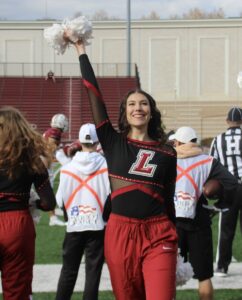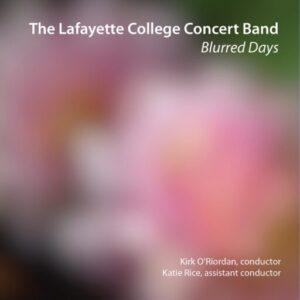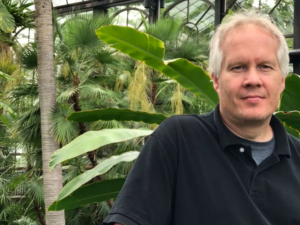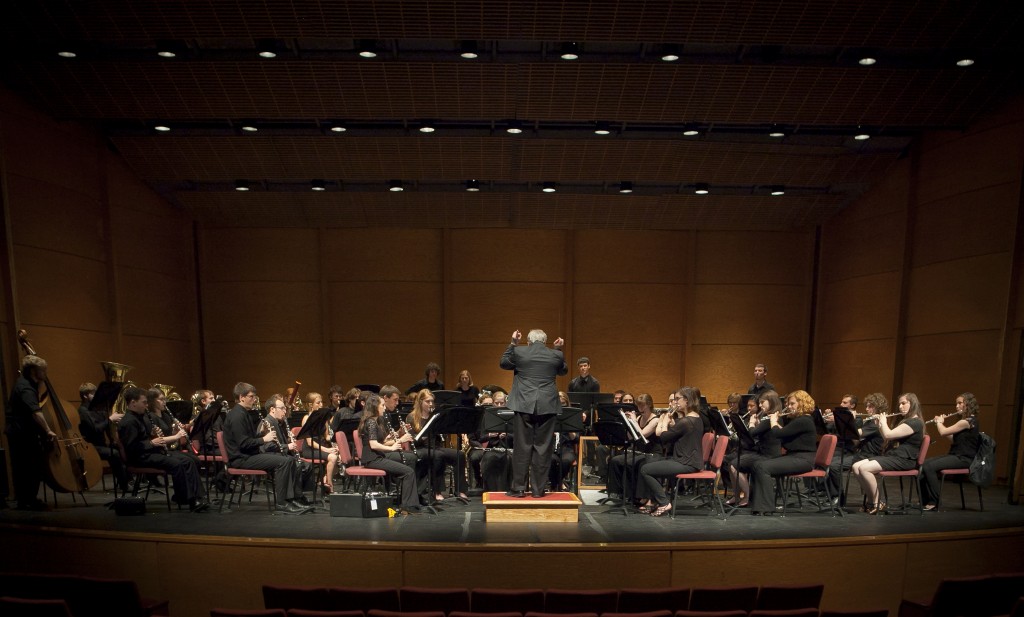Saturday December 9, 2023
Williams Center for the Arts
8:00 pm
Program
Toccata Marziale (1924)
Ralph Vaughn Williams (1872 – 1958)
Toccata Marziale, written in 1924, was Vaughan Williams’s second work for military band and is one of the most significant contributions to the wind band literature. The word “toccata” comes from the Italian toccare, meaning “to touch,” hence its association with the early Baroque virtuouso keyboard pieces written by Frescobaldi and others. Toccata Marziale is a contrapunctal masterpiece for wind ensemble, in which textures are juxtaposed in massed effects with large sections of winds and brasses. A rhythmic vigor, as suggested by the title, permeates the piece, and Vaughan Williams’s brilliant scoring reveals the fundamental properties of the band’s sonority and its instrumental virtuosity and color.
Notes by Frederick Fennell
Amazing Grace (1994)
Frank Ticheli (b. 1958)
I wanted my setting of Amazing Grace to reflect the powerful simplicity of the words and melody – to be sincere, to be direct, to be honest – and not through the use of novel harmonies and clever tricks, but by traveling traditional paths in search of truth and authenticity.
I believe that music has the power to take us to a place that words alone cannot. And so my own feelings about “Amazing Grace” reside in this setting itself. The harmony, texture, orchestration, and form are inseparable, intertwined so as to be perceived as a single expressive entity.
The spiritual, “Amazing Grace,” was written by John Newton (1725-1807), a slaveship captain who, after years of transporting slaves across the Atlantic Ocean to the New World, suddenly saw through divine grace the evilness of his acts. First published in 1835 by William Walker in The Southern Harmony, “Amazing Grace” has since grown to become one of the most beloved of all American spirituals.
The Manhattan Beach Music recording of AMAZING GRACE is performed by the California State University at Fullerton Wind Ensemble, Mitchell Fennell, conductor, Frank Ticheli, guest conductor. AMAZING GRACE was commissioned by John Whitwell in loving memory of his father, John Harvey Whitwell. It was first performed on February 10, 1994 by the Michigan State University Wind Symphony, John Whitwell conductor.
Notes by Frank Ticheli
A Hymn for the Lost and Living (2002)
Eric Ewazen (b. 1954)
On September 11, 2001, I was teaching my music theory class at the Juilliard School, when we were notified of the catastrophe that was occurring several miles south of us in Manhattan. Gathering around a radio in the school’s library, we heard the events unfold in shock and disbelief. Afterwards, walking up Broadway on the sun-filled day, the street was full of silent people, all quickly heading to their homes. During the next several days, our great city became a landscape of empty streets and impromptu, heartbreaking memorials mourning our lost citizens, friends and family. But then on Friday, a few days later, the city seemed to have been transformed. On this evening, walking up Broadway, I saw multitudes of people holding candles, singing songs, and gathering in front of those memorials, paying tribute to the lost, becoming a community of citizens of this city, of this country and of this world, leaning on each other for strength and support. A Hymn for the Lost and the Living portrays those painful days following September 11th, days of supreme sadness. It is intended to be a memorial for those lost souls, gone from this life, but who are forever treasured in our memories.
A Hymn for the Lost and the Living was commissioned by and is dedicated to the US Air Force Heritage of America Band, Langley Air Force Base, Virginia, Major Larry H. Lang, Director.
Notes by Eric Ewazen
Legacies (2010)
Clint Needham (b. 1981)
At the start of life, all doors are flung open wide. Every future is possible, every choice presents itself. So begins Legacies, naïve, jittery, excited, imbued with a sense of wonder and expectation.
Later in life there is more time to reflect inwardly upon the choices made, and things happen more deliberately; this introspection marks the middle slower section of the work. This is the core of the composition, its emotional center, representing the desire to remain where one is in life, versus the flux of life that pulls one forward into new experience. But the elemental spheres spin out energy in all directions, illuminating new pathways, propelling and pulling us ahead in time and in continual choice. These possibilities — these sound-pictures of what is yet to come — make up the last section. Here the opening music returns, but more complex, more layered, more harmonically gritty. Then, in a final burst of energy, the primary and secondary themes elide to create a joyous climax of forward momentum.
Notes by Clint Needham
Intermission
Suite Francaise (1944)
Darius Milhaud (1892 – 1974)
I. Normandie
II. Bretagne
III. Ile de France
IV. Alsace-Lorraine
V. Provence
For a long time I have had the idea of writing a composition fit for high school purposes, and this was the result. In the bands, orchestras, and choirs of American high schools, colleges and universities where the youth of the nation be found, it is obvious that they need music of their time, not too difficult to perform, but nevertheless keeping the characteristic idiom of the composer.
The five parts of this suite are named after French Provinces, the very ones in which the American and Allied armies fought together with the French underground of the liberation of my country: Normandy, Brittany, Ile-de-France (of which Paris is the center), Alsace-Lorraine, and Provence (my birthplace).
I used some folk tunes of these provinces. I wanted the young American to hear the popular melodies of those parts of France where their fathers and brothers fought to defeat the German invaders, who in less than seventy years have brought war, destruction, cruelty, torture, and murder three times to the peaceful and democratic people of France.
Notes by Darius Milhaud
Scenes from “The Louvre” (1966)
Norman Dello Joio (1913 – 2008)
I. The Portals
II. Children’s Gallery
III. Kings of France
IV. Nativity Paintings
V. Finale
Scenes from “The Louvre” comes from a 1964 television documentary produced by NBC News called A Golden Prison: The Louvre, for which Dello Joio provided the soundtrack. The documentary tells the history of the Louvre and its world-class collection of art, which is in many ways inseparable from the history of France.
Dello Joio chose to use the music of Renaissance-era composers in his soundtrack in order to match the historical depth of the film. He collected the highlights of this Emmy-winning score into a five-movement suite for band in 1965. The first movement, Portals, is the title music from the documentary, and it consists entirely of Dello Joio’s original material, complete with strident rhythms and bold 20th-century harmony. The second movement, Children’s Gallery, never actually appears in the film. It is a light-hearted theme and variations of Tielman Susato’s Ronde et Saltarelle. The stately third movement is based on themes by Louis XIV’s court composer, Jean-Baptiste Lully, and is aptly titled The Kings of France. Movement four, The Nativity Paintings, uses the medieval theme In Dulci Jubilo. The Finale uses the Cestiliche Sonata of Vincenzo Albrici as its source material, to which Dello Joio adds his own harmonic flavor, particularly in the final passages of the piece.
Notes by the Ohlone Wind Orchestra
My Favorite Pieces:
Jenna Tempkin (Senior, Flute)

My favorite piece that we are playing this semester is Eric Ewazen’s Hymn for the Lost and the Living. In band rehearsal I like to joke that we play 1 or 2 pieces that make me cry, and this one definitely takes that spot this time around. Although it is one of the easier pieces, I think the band’s musical passion comes out every time we play it. Since the piece was written to commemorate the events that occurred on 9/11, it starts off with a more somber melody. Although, one of the reasons I like playing it so much is because by the middle and end of the piece, the melody shifts to one that is much bolder. The two words that come to mind when playing that part of this piece are hope and strength, and it reminds me of the strength of the community the band and Lafayette has created for me. Finally, to me, this song reminds me a lot of one of my all time pieces I’ve ever played in LCCB, Somewhere from West Side Story.
Julia Sealing (First-year, Saxophone)
My favorite piece on the program is Hymn for the Lost and the Living, by Eric Ewazen. This piece was written to honor those who died on September 11, 2001, and it does an outstanding job of portraying the type of grief and loss that is hard to put into words. One reason I like this piece so much is because of how simple the melody is, and how its simplicity does not prevent it from expressing a range of emotions throughout the piece. Starting off with a reflective trumpet solo, the gradual addition of instrument groups adds to the intensity of the melody and makes it more complex by adding harmonies around it. As the melody is repeated in different instruments, feelings of both sadness and hope give way to angst and almost to triumph at the climax. However, even the most majestic parts retain the hint of grief that will never quite go away. This piece is powerful both to play and to listen to because of the emotional journey it takes you on.
Aram Ramsay (Sophomore, Clarinet)

My favorite piece is Norman Dello Joio’s Scenes from “The Louvre.” My favorite movements to play are the first, third, and finale. When we first sight read the first movement The Portals, I fell in love with the piece. This movement is so powerful, and it really shook me when we played it for the first time. Us clarinets also all really love the second movement Children’s Gallery. We love playing it because it’s so fun and playful. The finale is just fun to play. It’s simplistic, but sounds great. I love how the counter lines interact with the main themes of the movement.
The Lafayette College Concert Band
Flute
Samantha Semsel, Principal**
Jamie Lin
Iris Peluso
Jenna Tempkin, Associate Principal
Lauren Kaye
Dylan Eschinger
Brian Morris, Piccolo**
Oboe
Olivia Hoffman
Olivia Bamford
Nicole Bagdasarian
Clarinet
Emily Rice, Principal**
Aram Ramsay
Ashley Kushner-Kmetz
Priscilla Wu
Christopher Ruebeck
Sungbum Lee
Matthew Olson
William Cassidy
Peter Rice, Bass
Bassoon
Sean Catarroja
Saxophone
Julia Sealing, Principal (alto)**
Andrew Manni (alto)
Alex Kmetz (alto)
Chloe Williams (tenor)
Caleb Fossett (baritone)
Horn
Gavin Davis
Madeline Pagula
Trumpet
Drew Borek, Principal
Susanna Hontz, Associate Principal
Devin Arnold
William Blair
Josh Freiheiter
Kenneth Ho
Ian Horch
Trombone
Pedro dos Santos
Jackson Eshbaugh
Benjamin Zwicker
Christopher Taverner
Euphonium
Ryan Pignotti
Tuba
Jack Kerekes, Principal
Percussion
Ellie Batchelar, Principal
Henry Pappas**
Yuko Tanaka
Casey Alexander
Joe Freeston
Piano
Owen York**
Graduating Seniors
Lafayette Faculty
LCCB Alumni
Guest Performers
**Creative and Performing Arts (CaPA) Fellows
The Lafayette College Concert Band is comprised of approximately 50 students from a variety of majors who are united by a strong desire to perform the highest quality music at the height of their abilities. Participation in LCCB is open to students in any major as well as faculty and staff. The ensemble is conducted by Kirk O’Riordan, Associate Professor of Music.
LCCB typically performs one concert each semester. The repertoire is selected from traditional concert band masterpieces, newer works by established and emerging composers, commissions, and orchestral transcriptions. Past concerts have included works such as Husa’s Music for Prague 1968, Bernstein’s Symphonic Dances from West Side Story, both Holst Suites, Grainger’s Lincolnshire Posy, and Mussorgsky’s Pictures at an Exhibition. LCCB has premiered works by composer/conductor Kirk O’Riordan and 2010 Pesky Artist in Residence William Pfaff as well as Ashley Kushner ’19 and Zach Jones ’13.
Students enroll for 1/4-credit. Open to all students, faculty and staff, LCCB employs a wind ensemble model for instrumentation. A seating audition is required before the first semester of participation. Due to the large numbers of flutists, clarinetists, saxophonists, and trumpeters, the number of available seats in these sections is limited.
Several opportunities for leadership in the ensemble are available for highly motivated, experienced players. Principals in each section lead sectional rehearsals and help the less experienced players with technical issues. The Assistant Conductor is a highly advanced musician who has been studying conducting for at least one year prior to serving in the position. She/he conducts the ensemble on at least one piece in performance, having led all the rehearsals. Typically, that person also leads Pep Band and conducts the annual Marquis Players musical production. Finally, the LCCB President is nominated and elected by the student membership of the ensemble. This person works with the director and the Assistant Conductor on administrative tasks as a representative of the students.
Blurred Days CD
 Like many bands and other performing ensembles across the country, we have had to adapt to the pandemic. For us, this has meant that we have not been able to work together, in person. This has always been a band that thrives on its sense of community, and not having that has been hard on all of us.
Like many bands and other performing ensembles across the country, we have had to adapt to the pandemic. For us, this has meant that we have not been able to work together, in person. This has always been a band that thrives on its sense of community, and not having that has been hard on all of us.
But rather than mourn what we have lost, we have searched for opportunities within our remote format that are unique. Working in isolation has allowed us to re-examine the possibilities of the Wind Ensemble as an entity—to re-imagine what is possible with this collection of sounds.
The five pieces on this CD were written especially for us, and especially for our situation. Each of the pieces was conceived to take advantage of techniques that would not be possible in a traditional concert—effects on a person-by-person level, or writing for flutes in their lowest register.
To make these performances, each student recorded his or her part on their phones or computers and uploaded them to either a shared drive or to the web-based recording service Band Lab. Katie Rice assembled the tracks and performed the first round of editing. I took the tracks she finished and combined them into the final product, completing the pre-production audio work.
Every student has a unique track in the recording, which allows us to use studio effects on a person-by-person level. With many of the pieces, the individual parts were created to be non-linear—we could create specific sonic effects and duplicate them in the recording software. Several of the pieces incorporate improvisation, narration, and other unconventional techniques.
Kirk O’Riordan, Condcutor
 Kirk O’Riordan’s music has been referred to as “unapologetically beautiful” and is often praised for its uniquely “visual” qualities that depict a wide range of striking moods. His debut compact disk, Strange Flowers, was released by Ravello Records in November, 2013 and was praised by Audiophile Audition as “one of the most impressive and beautiful collections of chamber music I have heard in awhile….This is all just so lovely and invokes exactly the emotions that good music should be able to induce in all of us.” Gramophone Magazine praised O’Riordan as “a composer for whom imagery is a defining inspiration….[he] is a deeply sensitive composer who savours going gently into the night.” (April 2014).
Kirk O’Riordan’s music has been referred to as “unapologetically beautiful” and is often praised for its uniquely “visual” qualities that depict a wide range of striking moods. His debut compact disk, Strange Flowers, was released by Ravello Records in November, 2013 and was praised by Audiophile Audition as “one of the most impressive and beautiful collections of chamber music I have heard in awhile….This is all just so lovely and invokes exactly the emotions that good music should be able to induce in all of us.” Gramophone Magazine praised O’Riordan as “a composer for whom imagery is a defining inspiration….[he] is a deeply sensitive composer who savours going gently into the night.” (April 2014).
His recording of his Twenty-Six Preludes for Solo Piano—by pianist Holly Roadfeldt—has attracted similar praise: “are similarly atmospheric and proceed to unfold like a magical tapestry. Each of the 26 Preludes seemingly comprising of warp and weft forming a myriad of pixels of little pictures that ultimately combines to form a moveable feast for both eye and inner ear. O’Riordan’s miniatures are informed by languorous beauty and profundity, the lyrical variations of each often feature elaborate embellishments, as well as sudden dissonant figurations that seem to mimic the gravity-defying leaps of the gazelle…” (World Music Report, April 2017).
O’Riordan (b. 1968) is an active composer, conductor, saxophonist, and teacher. His music has been performed in Canada, China, Costa Rica, Cyprus, Finland, Italy, and Russia; and in thirty of the fifty United States. Performances of his works have been featured at the Ravenna Festival (Italy), the Indiana State University, University of North Carolina, Greensboro and Western Illinois New Music Festivals, the 2008 Eugene Rousseau Birthday Celebration, national and regional conferences of the Society of Composers, Inc. and the College Music Society; and in concert by such performers as the Eaken Piano Trio, Tresillo, The Moran Woodwind Quintet, Orchestra Bruno Maderna (Italy), the Arizona State University Chamber Winds and Symphony Orchestra, the Northwestern University Contemporary Music Ensemble, the Cleveland State University Orchestra, the University of Colorado Chamber Wind Ensemble, the University of Delaware University Singers, the Williamsport Chamber Chorus and Orchestra, the Susquehanna University Orchestra and Chamber Singers, The Lafayette College Concert Band, Contemporary Music Ensemble, and Percussion Ensemble, the SKIN Ensemble, Frederick Hemke, Timothy McAllister, Lawrence Stomberg, Marianne Gythfeldt, Kenneth Tse, Jeffrey Lyman, Emily Bullock, Steven Stusek, Andrew Rammon, Reuben Councill, John Perrine, and Holly Roadfeldt.
Kirk is the recipient of numerous awards as both a composer and a performer, including annual ASCAPlus awards, a Composer’s Assistance Program grant from the American Music Center, the 2001 Arizona State University Composition Competition, the 2000 Contemporary Music Society competition, and an ERM-Media Masterworks Prize. In addition, his Cadenza for Piano Trio was one of two works selected by audience members at the CMS Mid-Atlantic/Northeast Super-regional Conference for performance at the 2008 CMS National Conference.
Kirk’s music has been broadcast on WSMR, KBAQ, WQSU, and WVIA radio. Recordings of his works appear on the Crystal Records, Ravello, Centaur, ERM-Media and EnF labels, and feature performances by Kenneth Tse, Lawrence Stomberg, Marianne Gythfeldt, Holly Roadfeldt, Frederick L. Hemke, The Kiev Philharmonic, and Farrell Vernon. He has recently received commissions from AVIDduo, Saxton Rose, and Holly Roadfeldt. He recently completed his first opera: The Masque of Edgar Allan Poe, a one-act chamber opera based on Poe’s “Masque of the Red Death” on a libretto by Lafayette College colleague Lee Upton. The work was premiered by the University of Delaware Opera Theater in November, 2016 and subsequently at Lafayette College. Other projects have focused on music for dance: his River Lights for Orchestra (as recorded by the Kiev Philharmonic) was used by dancer/choreographer Ben Munisteri in his piece, Robot vs. Mermaid. O’Riordan has also collaborated with dancer/choreographers Carrie Rohman and Nandini Sikand. Recent projects include a concerto for Taiko Ensemble and Concert Band (for the Lafayette College Percussion Ensemble and Concert Band), incidental music for a Lafayette College Department of Theater production of Mary Zimmerman’s play Metamorphosis, and a new work for viola and piano for violist Michael Hall and pianist Holly Roadfeldt.
Dr. O’Riordan joined the faculty of Lafayette College in 2009, and now serves as Associate Professor of Music and Director of Bands, teaching courses in music theory, and composition. In addition, he teaches in the First-year Seminar program and conducts the Lafayette College Concert Band and Contemporary Music Ensemble. During his time at Lafayette, the Concert Band has been hailed for its ambitious and adventurous programming, having performed works such as Husa’s Music for Prague 1968, his own orchestration of Pictures at an Exhibition, and world premieres by O’Riordan, Ashley Kushner, Justin Kogasaka, Zach Jones, Pete Deshler, and William Pfaff. Previously, he served on the faculties of Bucknell University and Susquehanna University where he taught music theory, composition, music appreciation, and (English) writing. He has also served on the faculties of Lock Haven University, Colorado Christian University, Chandler-Gilbert Community College, and Paradise Valley Community College. He holds the Doctor of Musical Arts degree from Arizona State University (the first recipient of that degree from ASU); the Certificate of Performance in Saxophone from Northwestern University; and three Master of Music degrees (composition, saxophone performance, and conducting).
Kirk has studied composition with Rodney Rogers, Randall Shinn, James De Mars, Glenn Hackbarth, Jay Alan Yim, Burton Beerman, Marilyn Shrude, and Donald M. Wilson. He has studied saxophone with Frederick L. Hemke, John Sampen, Eugene Rousseau, and Iwan Roth. In his free time, Kirk is an avid fan of Obstacle Course Racing.
